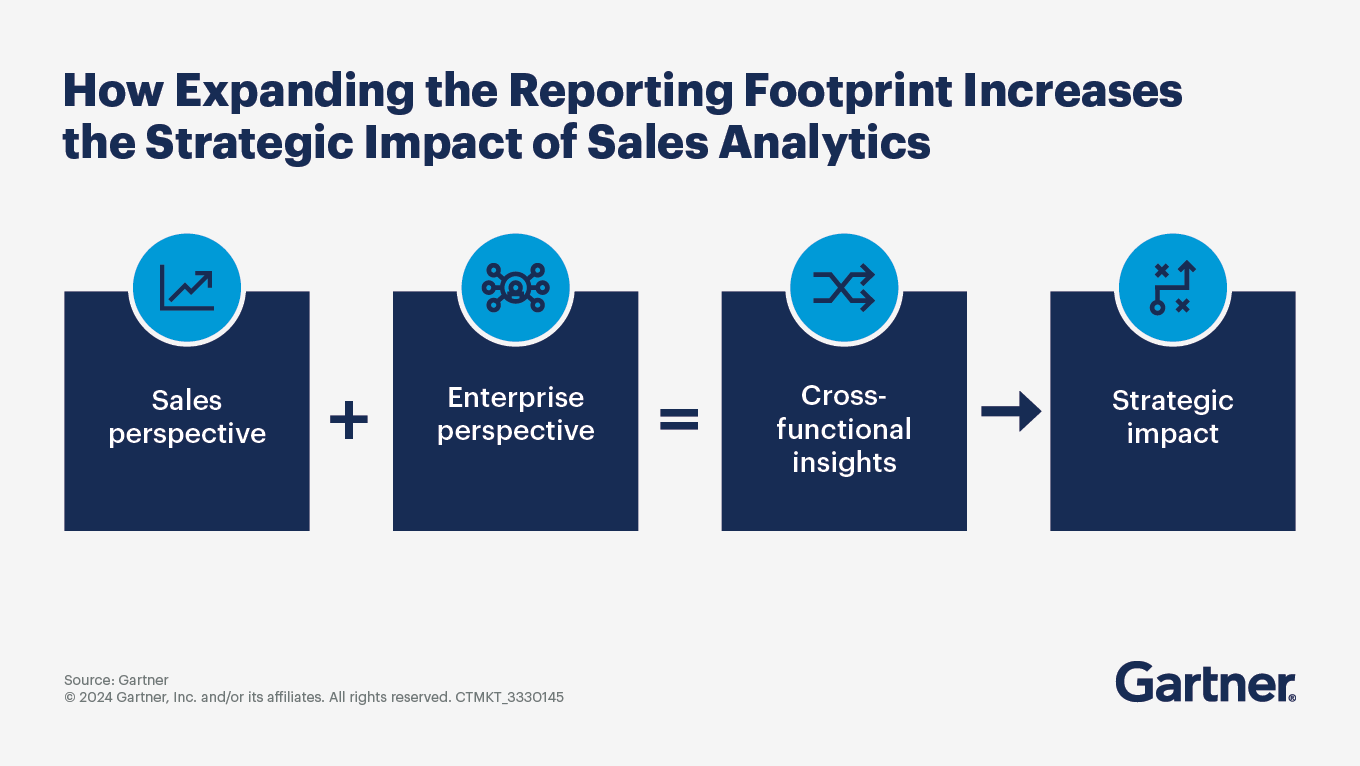Follow these proven best practices to increase sales analytics’ value to your organization.
- Gartner client? Log in for personalized search results.
Immediately Improve Your Sales Analytics Programs
By Nate Eisinger, Tyler Huguley and Steve Rietberg | February 6, 2025
Sales analytics programs must change to increase their value
Perhaps paradoxically, new technologies and greater data visibility often make it harder for sales leaders to get solid data-driven insights from their sales analytics programs. Forty-seven percent of sales operations and RevOps leaders list data integration across different systems and platforms as a top data-quality challenge, and 40% report inaccurate data stemming from user input as an issue. Combine this with the fact that those outside the sales operations team may choose their own means of analyzing sales data, and it’s clear that sales analytics programs need to change.
Sales operations leaders can mitigate risks to the success of their sales analytics program — and even turn common challenges into a competitive advantage for their organization — by focusing their efforts on three high-impact changes.
Sales analytics: 3 changes to start making today
Sales operations leaders can improve their sales analytics programs by expanding sales analytics’ footprint beyond commercial data inputs, calibrating team structure based on emerging challenges to maximize ROI, and replacing point predictions with probabilistic forecasting.
Expand the sales analytics footprint
While traditional dashboards have been on the decline, sales operations leaders can enhance dashboards’ value by taking a cross-functional, enterprise-level approach to sales analytics. This reflects a broader trend of sales operations supporting non-sales functions, such as supply chain, finance and customer service.
Expanding the sales analytics lens allows both sales and non-sales teams to answer questions across crucial business priorities, such as talent planning, spending and product roadmaps. The benefits from a broader span of analytics insights include:
Greater strategic impact for sales analytics, with a footprint beyond commercial inputs
Unified data to streamline analytics and insights consumption across teams
Technology proliferation to enable data synthesis across systems
Improvement in sales operations’ ability to gather and deliver coherent, cross-functional analyses
Maximize the sales analytics ROI
To increase the ROI of sales analytics, sales operations leaders must adapt team structures to address emerging challenges. While the skills behind the traditional generalist model — emphasizing versatility, collaboration and ongoing relationships — remain relevant, data complexity and the proliferation of RevTech make clear that new skills are also required.
A specialist model can offer advanced capabilities in data processing, application configuration and synthesizing data insights. It boosts efficiency, encourages cross-functional collaboration and improves the sales analytics program’s performance.
To migrate to a specialized approach:
Identify the skills needed for success, and document whether they are currently found within the team or cross-functionally.
Recombine common skills into new specialist roles (e.g., data scientists, citizen data scientists and data quality specialists).
Evaluate different role designs with budget top of mind.
Switch to probabilistic forecasting
Mastering predictive analytics can be difficult for sales operations leaders, resulting in stakeholder frustration. The hype around artificial intelligence and machine learning technologies has led many to expect a “crystal ball” that makes highly accurate sales predictions. Sales leaders only add to the confusion when they present the most likely outcome — a point estimate — as the predicted value.
Shifting to a probabilistic forecasting approach helps sales leaders set the right expectations and help audiences make better business decisions. To make this change, lean on techniques such as:
“Best/worst/most likely” scenarios that communicate ranges rather than data points
Confidence intervals that help the audience understand how much to trust a prediction
Contextual explanations that account for economic uncertainties such as inflation and the emergence of new competitors
Sales analytics FAQs
What is sales analytics?
Sales analytics is used to identify, model, understand and predict sales trends and outcomes. Specifically, sales analytics systems support discovery, diagnostic and predictive exercises that enable the manipulation of parameters, measures, dimensions or figures as part of an analytic or planning exercise. As a result, sales operations leaders can identify opportunities for improvement and enable smarter decisions.
What is the generalist approach to sales analytics?
In the generalist approach to sales analytics, team members are each responsible for a wide variety of tasks, from designing and producing reports to configuring and managing tools. Each team member has the necessary technical skills to perform multiple duties for a certain business unit, sales team or product line. For some organizations, shifting to a specialist approach can yield results.
Attend a Conference
Join Gartner experts and your peers to accelerate growth
Gather alongside your peers in Las Vegas to gain insight on emerging trends, receive one-on-one guidance from a Gartner expert and create a strategy to tackle your priorities head-on.
Gartner CSO & Sales Leader Conference
Las Vegas, NV

Drive stronger performance on your mission-critical priorities.
